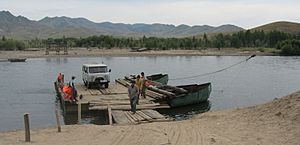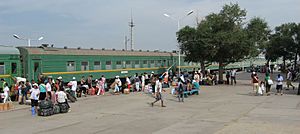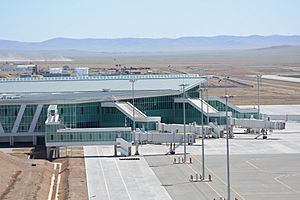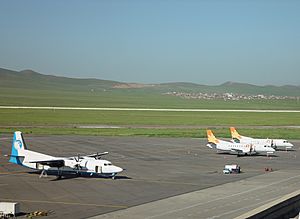Transport in Mongolia facts for kids
The transportation system in Mongolia helps people and goods move around. It includes a network of railways, roads, waterways, and airports. This system is very important for connecting different parts of the country and for trade with other nations.
Contents
Railways in Mongolia
Mongolia has a railway system that helps transport many things. The most important line is the Trans-Mongolian Railway. This railway connects Russia (starting from Ulan Ude) to China (going to Erenhot and Beijing). It passes right through Ulaanbaatar, which is the capital city of Mongolia. The part of this railway in Mongolia is about 1,110 kilometers long.
There are also smaller railway lines, called spur lines. One connects Darkhan to the copper mines in Erdenet. Another line links Ulaanbaatar to the coal mines in Baganuur. In the eastern part of Mongolia, there's a separate railway line between Choibalsan and a place called Borzya in Russia. However, this eastern line is not open for passengers past the Mongolian town of Chuluunkhoroot.
Trains run daily for people traveling within Mongolia. You can take a train from Ulaanbaatar to places like Darkhan, Erdenet, and Zamyn-Üüd. Mongolia uses a specific type of railway track called the Russian gauge, which is 1520 millimeters wide. The total length of all railway tracks in Mongolia is about 1,810 kilometers. In 2007, trains carried most of Mongolia's goods (93%) and a lot of its passengers (43%).
Roads in Mongolia
Mongolia's road network has been growing. In 2007, only about 2,600 kilometers of roads were paved. Another 3,900 kilometers were covered with gravel or improved in other ways. By 2013, the paved road network had grown to 4,800 kilometers. A big part of this, 1,800 kilometers, was finished in 2014 alone.
These new paved roads include important routes. There are roads from Ulaanbaatar to the borders with Russia and China. A paved road also connects Ulaanbaatar to Kharkhorin and Bayankhongor. Another goes south to Mandalgovi. There's also a road from Lün to Dashinchilen, and from Darkhan to Bulgan through Erdenet. Most of Mongolia's official roads, about 40,000 kilometers, are simple dirt tracks across the land.
Work is still happening on new roads. An east-west road, sometimes called the Millennium Road, is being built. This includes the road from Ulaanbaatar to Arvaikheer. The Darkhan-Bulgan road is also being extended past Bulgan. Private companies offer bus and minibus services from Ulaanbaatar to most of the main towns in different aimags (provinces).
In 2014, new roads were finished connecting Dalanzadgad (in Ömnögovi Province) and Mörön (in Khuvsgul province) to the capital city, Ulaanbaatar. In 2019, Mongolia opened its first expressway. This road, called the Ulaanbaatar Airport Expressway, makes it faster to get to the airport.
Buses in Mongolia
Public transportation in Mongolia began in 1929. The first public bus route was in Ulaanbaatar, running between the city center and Amgalan. Buses ran five times a day back then.
Today, buses are the main way people get around in Ulaanbaatar. Buses usually arrive at stops every 15 minutes. They operate from 7:00 AM to 10:00 PM. As of 2020, there are about 900 to 950 buses running daily in Ulaanbaatar. You can also take an international bus from Ulan-Ude, Russia, to Ulaanbaatar.
Bus transport between cities in Mongolia is also well-developed. You can find everything from minivans to large coach buses with up to 45 seats. The government works with private companies to run many bus lines across the city. Ulaanbaatar also has a trolleybus system, which uses electric buses powered by overhead wires. Some of the main bus companies include Avtobus 1, Avtobus 3, Tenuun Ogoo LLC, Erdem trans LLC, and Sutain buyant LLC.
Taxis in Mongolia
In Ulaanbaatar, there are about 10 official taxi companies. These include Ulaanbaatar taxi and Noyon taxi. Together, they have around 600 cars. Smaller cities like Darkhan, Erdenet, and Baganuur also have local taxi companies. Besides these official taxis, many private drivers use their own cars to offer taxi services.
A typical taxi ride costs about 1,500 Mongolian Tugriks (MNT) per kilometer. Sometimes, taxi drivers might ask for more, especially from foreign visitors. Since October 2013, official taxis with proper markings are allowed to use the first lane of Ulaanbaatar's main road. This lane is usually only for large public transport vehicles like buses and trolleybuses.
Waterways in Mongolia
Mongolia has about 580 kilometers of waterways. However, only Lake Khövsgöl has been used a lot for transport. The Selenge River (270 km) and the Orkhon River (175 km) are navigable, meaning boats can travel on them. But they don't carry much traffic. A customs boat does patrol the Selenge River up to the Russian border. On Lake Khövsgöl, tourists can find charter boats for rides. The lakes and rivers in Mongolia freeze during winter. They are usually open for boats between May and September.
Air Transport in Mongolia
MIAT Mongolian Airlines is Mongolia's main airline. It started operating in 1956. In the past, it flew scheduled domestic flights from its main airport, Buyant-Ukhaa International Airport. It began international flights in 1987. After Mongolia became a democracy, the airline started using modern jet planes and expanded its international routes. Since the 2000s, new private airlines like Aero Mongolia, Hunnu Air, and Eznis Airways have started flying. They now handle most of the domestic flights within Mongolia. In 2023, MIAT Mongolian Airlines started domestic flights again after 15 years, under the name MIAT Regional.
Mongolia opened a new airport, the Chinggis Khaan International Airport (UBN), in July 2021. It is located about 50 kilometers from the center of Ulaanbaatar. This new airport replaced Buyant-Ukhaa and is now the only international airport in the country. Most of the airports in Mongolia's 21 aimag centers have paved runways. However, those closest to Ulaanbaatar do not have regular scheduled flights.
You can fly directly to Ulaanbaatar from many places in Europe and Asia. There are also plans for future direct flights to North America and Australia.





